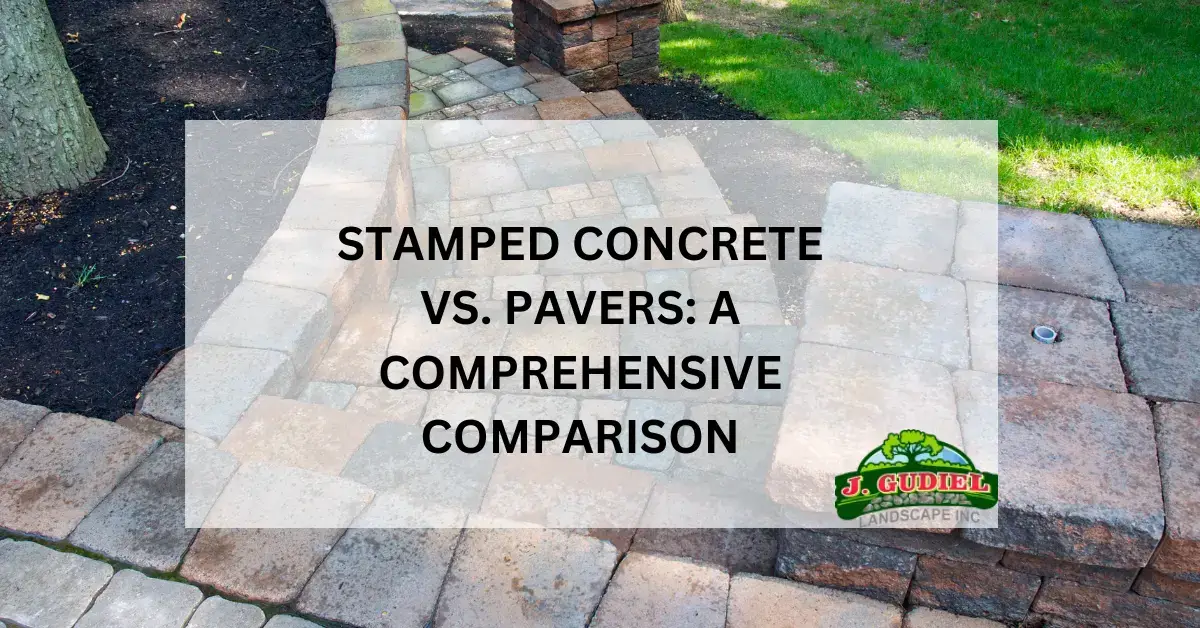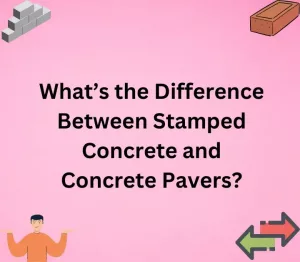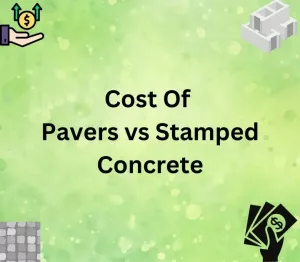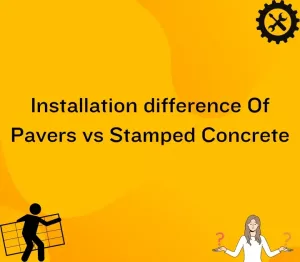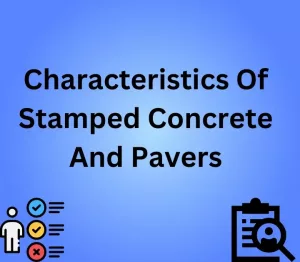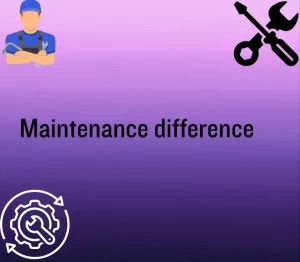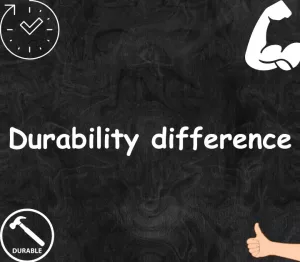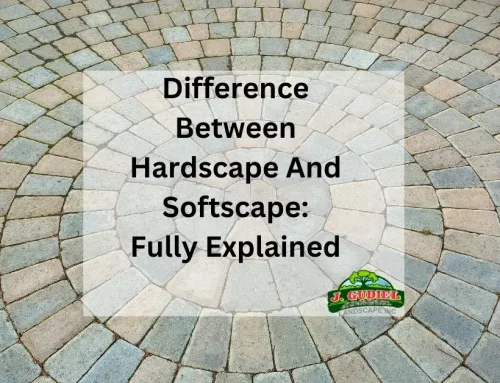Choosing between stamped concrete and pavers for your outdoor area? Let’s break it down simply: we’ll compare their costs, installation, maintenance needs, durability, and what makes each one unique. Whether you’re thinking about your budget, how they’re installed, or how long they’ll last, we’ve got you covered. By the end, you’ll have a clear idea of which option suits your style and needs best.
What’s the Difference Between Stamped Concrete and Concrete Pavers?
The main difference between Stamped Concrete and Pavers is that stamped concrete is poured and then made to look like bricks or stones, while pavers are like big, flat bricks that fit together. If they break, pavers are easier to replace, and you can make more designs with them.
Similar Functions
Pavers and stamped concrete are alike because they both last a long time and make your place look nice. Now, let’s learn more about them.
Cost Of Pavers vs Stamped Concrete
Let’s discuss their cost.
When deciding between stamped concrete and concrete pavers, weighing both the initial installation costs and the long-term repair and maintenance expenses is essential. The cost of stamped concrete typically ranges from $8 to $18 per square foot, while the cost of pavers can go up to $20 per square foot due to the labor-intensive process of laying them by hand.
However, concrete pavers are often less costly to repair or replace over time, potentially making them more economical in the long run. Factors such as the job’s complexity and local market prices for materials and labor also significantly determine overall costs.
To make an informed decision, obtaining estimates from contractors for both options is advisable. This allows you to determine the most affordable choice for your project while considering your budget constraints and desired aesthetic.
Regardless of which option you choose, it’s essential to remember that both stamped concrete and concrete pavers generally come at a higher cost than plain poured concrete. Therefore, it’s essential to carefully assess your needs and priorities to select the best option for your specific circumstances.
Installation difference Of Pavers vs Stamped Concrete
The Installation differences between pavers and stamped concrete are mentioned below.
We recommend hiring a professional for the installation of both stamped concrete and precast pavers and slabs. For stamped concrete, achieving the correct mix of cement and water is crucial to ensure proper curing and prevent premature bubbling or cracking. Similarly, for precast pavers, a professional ensures that the surface is adequately compacted before laying the blocks.
Both stamped concrete and precast concrete pavers require installation over a well-compacted, properly graded subgrade, resulting in similar preparation times and effort. However, the placement process tends to be lengthier for concrete pavers due to the labor-intensive task of individually placing each unit. It may take around three days to complete a 2,000-square-foot driveway installation, depending on the project’s complexity.
One advantage of concrete pavers is their ability to withstand foot or vehicle traffic immediately after placement. In contrast, poured-in-place concrete typically requires at least 24 hours to cure before allowing foot traffic and up to seven days before accommodating vehicle traffic.
Characteristics Of Stamped Concrete And Pavers
Characteristics Of Stamped Concrete
Color:
Stamped concrete offers a wide range of color options using integral pigments or surface-applied stains. Colors can be customized to match or complement existing structures or landscaping.
Texture:
Stamped concrete can replicate the texture of natural materials such as stone, brick, slate, or wood. The texture is achieved by pressing molds or stamps onto the concrete surface during the pouring and finishing.
Shape:
Stamped concrete can be poured into custom shapes or patterns to achieve specific design goals. Using stamps and molds, contractors can create intricate patterns, borders, or decorative motifs.
Characteristics Of Pavers
Color:
Pavers are available in various colors, ranging from earthy tones to vibrant hues. The color options may vary depending on the material used for the pavers, such as concrete, brick, or natural stone.
Texture:
Pavers have inherent texture based on the material they are made from. For example, concrete pavers may have a smooth or textured surface, while natural stone pavers often feature irregular textures and variations in finish.
Shape:
Pavers come in various shapes, including rectangular, square, circular, and interlocking designs. The versatility in shapes allows for creative arrangements and layouts, such as herringbone, basket weave, or running bond patterns.
Maintenance difference Of Pavers vs Stamped Concrete
Both stamped concrete and concrete pavers need regular cleaning and maintenance to stay in good shape and protect against damage. Applying a sealer every few years helps preserve their appearance and durability. However, maintaining the joints between concrete pavers can require extra effort, like refilling sand every few years to prevent weeds and adjusting or replacing pavers as they shift over time. Stamped concrete, although less demanding initially, may develop cracks over time due to weather and weight, requiring more extensive repairs.
While stamped concrete needs resealing every one to two years, pavers generally require less frequent maintenance, although occasional sand replacement may be necessary. For durability, pavers are often the better choice.
Durability difference Of Pavers vs Stamped Concrete
Pavers and stamped concrete have advantages and durability factors, but there are differences between them.
Durability of Pavers
Strength:
Pavers are known for their strength. They can handle heavy loads and are less prone to cracking under pressure compared to stamped concrete.
Flexibility:
Pavers have joints between them, which allow for slight movement without causing damage. This flexibility helps them endure freeze-thaw cycles and shifting ground conditions better.
Repairability:
If one paver gets damaged, it can be replaced individually without affecting the rest of the pavement. This makes maintenance relatively easy.
Longevity:
With proper installation and maintenance, pavers can last for decades.
Durability of Stamped Concrete
Strength:
Stamped concrete is durable and can handle light to medium traffic and weather conditions. However, it may be more prone to cracking over time, especially if not properly reinforced.
Surface Wear:
The stamped pattern on concrete can wear off over time, especially in high-traffic areas, which may require resealing and periodic maintenance.
Repair:
Repairing stamped concrete can be more challenging than pavers. Cracks may need to be patched, and re-stamping can make it difficult to match the existing pattern.
Longevity:
While stamped concrete can last a long time with proper care, it may have a different lifespan than well-maintained pavers.
Factors to Consider
Installation:
Proper installation is crucial for both pavers and stamped concrete to ensure durability.
Climate:
Weather conditions like freeze-thaw cycles, heat, and moisture can affect longevity.
Maintenance:
Regular upkeep, including sealing and cleaning, prolongs lifespan.
Cost:
Initial expenses and long-term maintenance should be weighed.
In summary, pavers generally offer superior durability, repairability, and flexibility compared to stamped concrete. However, the choice depends on personal preference, budget, and project needs.
Conclusion
Choosing between stamped concrete and pavers depends on individual preferences, budget, and project needs. Stamped concrete offers a wide range of patterns and colors but requires regular resealing and may be prone to cracking over time. On the other hand, pavers provide versatility in design, easy replacement of damaged units, and greater durability. Understanding these differences can help make an informed decision for your landscaping or paving project.
For more exciting content follow us on Yelp Facebook Instagram
FAQs
Q1:Are pavers cheaper than concrete?
A: Pavers may have a higher initial cost than poured concrete due to materials and installation, but their durability often translates to lower long-term maintenance expenses, making them a cost-effective choice in the long run.
Q2: What are the main differences between stamped concrete and pavers?
A: Stamped concrete is poured and stamped to mimic the look of natural materials like stone or brick, while pavers are individual units laid in a pattern. Pavers offer more design flexibility and easier repairs compared to stamped concrete.
Q3: Which option is more durable, stamped concrete, or pavers?
A: Pavers are generally considered more durable than stamped concrete. They can withstand heavy loads and are less prone to cracking over time. However, proper installation and maintenance are essential for both to ensure longevity.
Q4: Are stamped concrete or pavers more expensive?
A: The cost of stamped concrete versus pavers can vary depending on factors such as materials, installation complexity, and project size. Generally, stamped concrete may have a lower upfront cost, while pavers may offer better long-term value due to their durability and lower maintenance needs.

